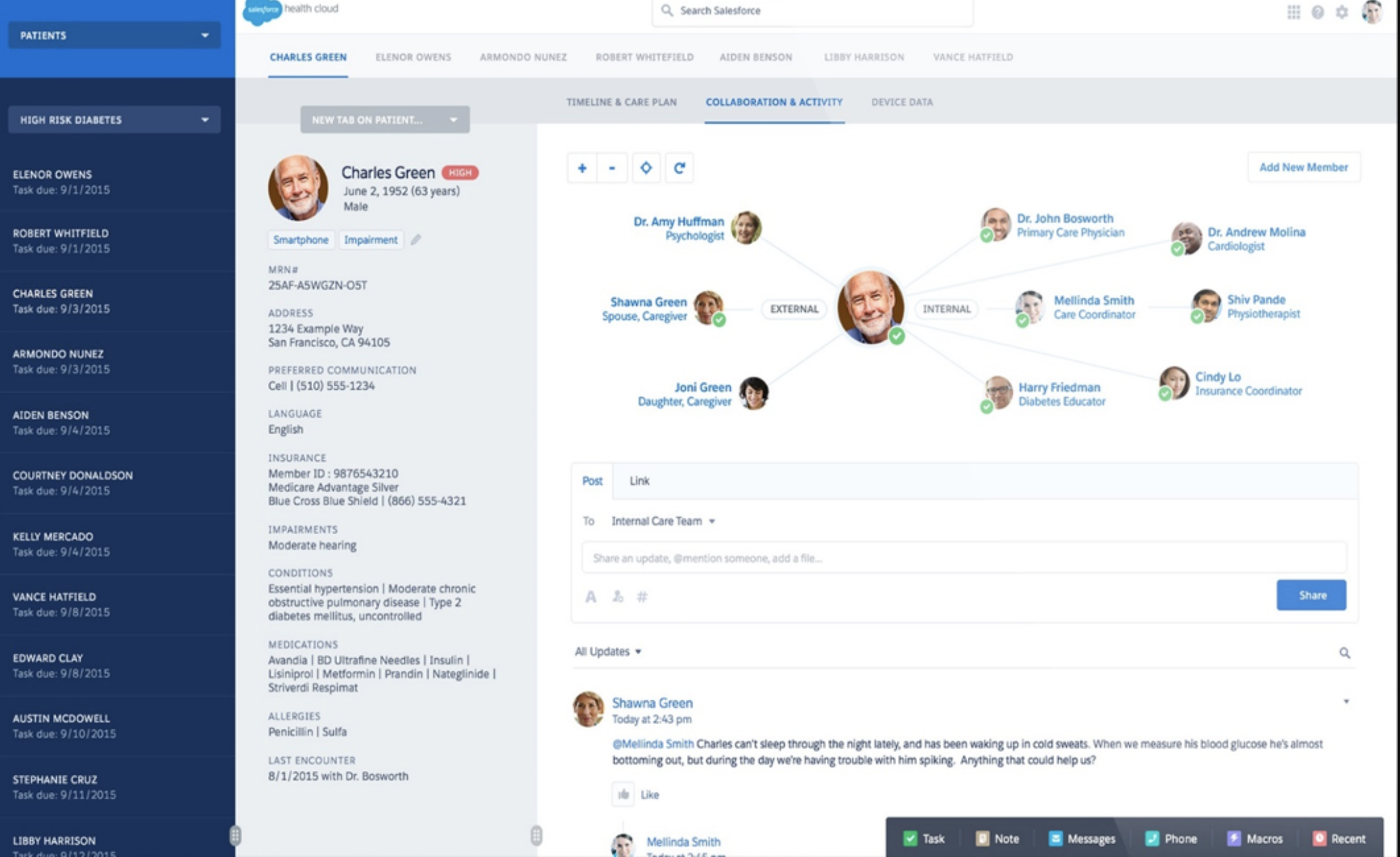Disclaimer: These are my private opinions and experiences and not an official Salesforce post.
Why this post?
Since 2015 Salesforce offers an Industry platform, namely the Health Cloud. Even though the Health Cloud offers Industry specific capabilities for Life Sciences, we are still coming across a lot of situations where customers or implementation partners decide to configure or customize a Sales- / Service Cloud org to meet industry standard requirements. With this approach customers eventually end up paying more, as it comes with a higher total cost of ownership in the long run. If we ask why they decided to build instead of buying, these are the main reasons:
- Customers/Partners don’t know that Salesforce offers Industry Clouds
- They know but are not familiar with what Health Cloud has to offer
- Customizing seems cheaper compared to license costs
This is why I have decided to write this post which answers the question why Salesforce decided to build an Industry Solution, Salesforce’s Vision on Life Sciences, What capabilities it comes with, Typical use cases and why Customers and partners should be using the Health Cloud instead of building something on their own.
But let’s start from the beginning.
What Health Cloud is and why it exists
On September 2nd 2015 Salesforce published a statement with following title Salesforce Introduces Salesforce Health Cloud — Building Patient Relationships, Not Records
This was great news to customers as it showed that Salesforce had listened to the market feedback and noticed that industry related trends such as:
- Outcomes-based reimbursements
- Personalized Treatments
- Demographic change and offering more tech-savvy ways to manage the Patient Relationship
are pressuring Life Sciences customers to work on new offerings and technical investments to meet the market expectations. To take that burden off customers shoulders the Health Cloud was born.
Up until 2015 Salesforce didn’t provide an industry specific solution for Health Care and Life Sciences (HLS). As a result customers had to rely on Independent Software Vendors (ISVs) and implementation partners who configured and customized Service or Sales Cloud orgs to meet Industry specific requirements like Patient Services or MedTech Sales.
Before we look into what the Health Cloud specifically is and provides, let’s continue with Salesforce’s view on the future of Life Sciences.
The Future of Life Sciences on the Salesforce Platform
Let me start this section with a quote from UX Design: If They Don’t Notice You, You’re A Success
If we look at Salesforce’s history and one of the many reasons for its continuous success, it’s the fact that it breaks down complicated processes and makes the job for end users easy and simple so they can focus on their work. Let me explain. The Life Sciences value chain is typically a Linear, Disconnected Process. There is R&D, Trial Management, CROs, CDMOs, Quality and Approvals, Market Access, Logistics, Governance, Commercial Launch, Patient Services etc.
Salesforce can be the connective tissue bringing all these informations together in a simplified and easily accessible way. This will help creating better outcomes for all involved stakeholders.
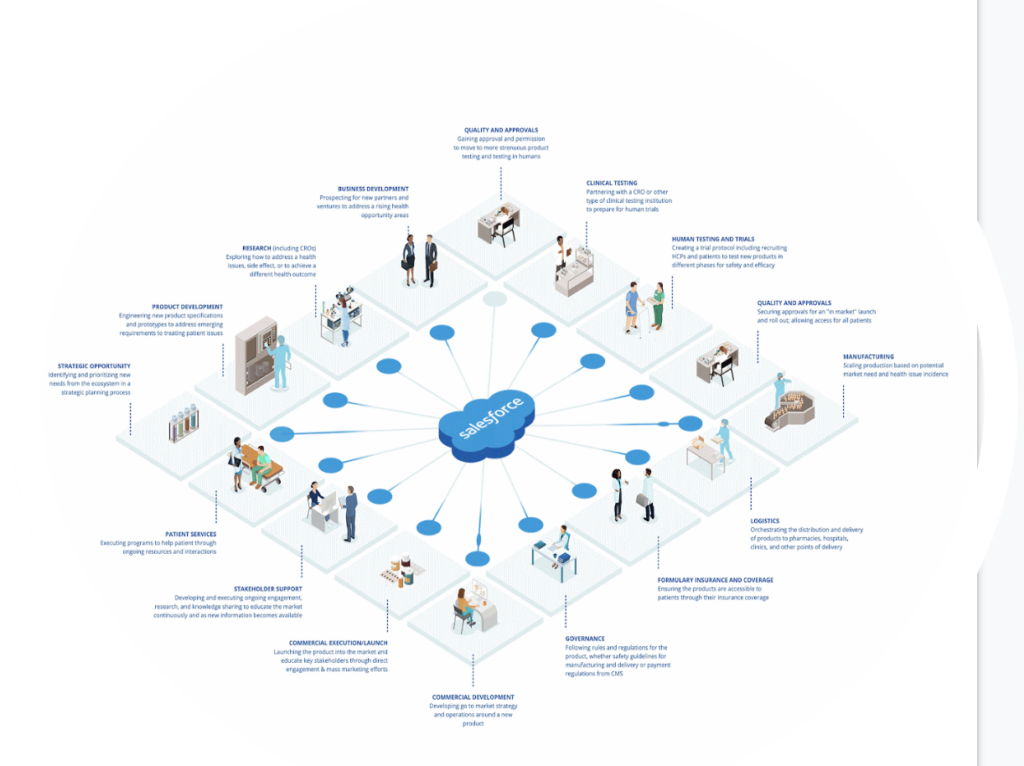
What Salesforce offers to meet these challenges
Salesforce offers healthcare companies a single system of engagement across their ecosystem anytime, anywhere. Whether it’s marketing, sales, benefits administration, customer service, and/or care coordination, the healthcare consumer journey becomes seamless to drive better outcomes in the industry.
The value of such a strategic Health platform can be broken down into 5 steps:
- System of Engagement – Salesforce is the engagement platform that breaks down complex processes into simple tasks
- Operating Applications – It offers several different system of record Apps
- System of Interoperability – It combines the Clinical and Non-Clinical Data from multiple sources
- System of Productivity – A platform that unlocks teams and connects the apps that empower collaboration
- System of Intelligence – An Intelligent platform that uses smart nudging to move action to outcome.
When we talk about the vision of bringing all Life Sciences stakeholders together on a unified Health platform and making orchestration between them easier, it may sound like nothing special and something that should always be given. Yet many companies fail to provide such a platform to their stakeholders.
In our conversations with customers it is not immediately clear to them on how a platform that still needs additional integrations and implementation efforts to provide its full value and solve their business challenges, is helpful for them. Once they do see the Health Cloud in action however, they don’t want to go back to how it was before. This is where I want to come back to the above quote “If They Don’t Notice You, You’re A Success”: It is easy to forget the value of a good engagement platform as its brilliant design and simplicity seems effortless and can mistakenly be taken for granted. Only its absence will make users and customers realize how powerful it really is.
While integrations and implementation efforts are always part of a strategic project, your stakeholders life will be easier and you will be faster in delivering business applications with Salesforce eventually. It may sound like “just” an additional system in your IT landscape at first, but its true value lies in being the connective tissue and consolidating complex healthcare information from multiple sources in an easily accessible way and adding helpful functionalities like Artificial Intelligence, Business Automation, Analytics, Portals etc. on top of it. Your companies strategic Health Platform, if you will.
If Salesforce has always been providing the value of bringing multiple stakeholders together and orchestrate complex processes, why does it need a new solution you may ask? The next section answers that question.
Health Cloud Value
Now that we have covered Salesforce’s strategy for HLS let’s see how it has been incorporated into the Health platform.
Since the Health Cloud is built on the Salesforce platform it takes all that Salesforce already offers and contextualizes it for the healthcare and life sciences industries to accelerate time to value. It comes with built custom features designed specifically for provider, payer, pharmaceutical and medical device organizations. With the patient relationship always top-of-mind, it connects data from legacy systems and electronic health records (EHR), providing a complete view of the patient and other stakeholders. This includes clinical and insurance data models, longitudinal health timeline, social determinants and much more. The value is extended even further with a complete partner ecosystem and continual innovation with three releases per year.
It also allows for care team collaboration. A care team is made up of health professionals who provide coordinated care specific to the patient’s needs and circumstances. Care teams create the personalized end-to-end experience, the patient journey.
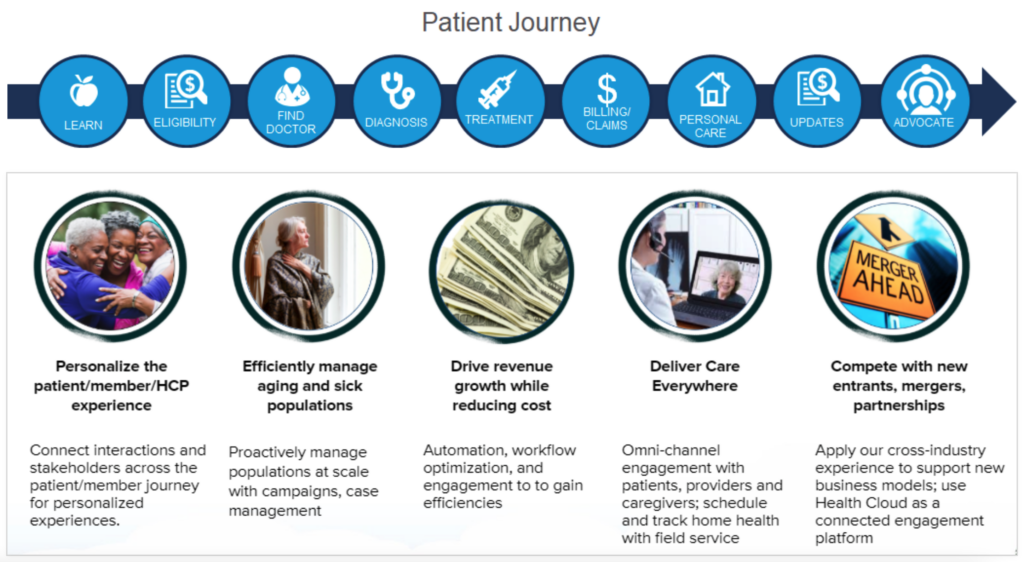
Salesforce Health Cloud allows organizations to put the patient, the member at the center of everything they do by enabling digital communication across the patient’s care team while preserving the patient’s preferences and privacy.
Health Cloud Supports Multiple Sub-Verticals
Reducing IT complexity and harmonizing technology where possible are strategic topics for all of our customers. With the Industry Solution Healthcare and Life Sciences companies can rest assured that multiple business units can benefit from the platform as it supports several sub-verticals like:
Provider’s
Gain a holistic patient view
Understand the entire patient journey and elevate patient-centric experiences by connecting clinical data, social determinants, preferences and more
Deliver care from anywhere
Expand patient access in the home, online, or in-person with digital self-service tools and integrated health data on one secure platform
Strengthen provider relationships
Efficiently manage your physician network and improve collaboration with a unified provider record and guided workflows
Payer’s
Understand the entire member journey
Build trust at every member interaction on a unified platform, from enrollment, service, to care management and beyond
Influence the best health outcomes
Engage in proactive interventions with holistic health data, utilization management, and customized care plans
Enhance provider network management
Manage your provider network from one system, including recruitment, onboarding, and relationship management
MedTech
Improve sales team engagement
Centralize the right data to standardize processes, automate tasks, and surface insights on any device
Surface commercial planning insights
Align business units around a single view for real-time variance analysis of new opportunities, run-rate performance, and field inventory
Drive patient connections before and after care
Build and scale patient programs to reduce operational costs and drive patient engagement
Pharma
Demo here
Streamline patient engagement processes
Scale therapeutic-specific support programs to reduce operational costs and get more patients on therapy faster
Drive patient service team collaboration
Break down data silos with the most trusted and advanced integrations to accelerate innovation and ensure compliance
Surface proactive, data-driven insights
Identify patient and HCP insights with built-in analytics for better program results and personalized experiences
Let’s have a look in how this is technically possible.
Health Cloud Architecture
In the below screenshot you can see a visualization on how the Health Cloud comes with Industry specific data models, processes and functionalities, so customers don’t have to manually build it themselves. This allows customers to leverage pre-built functionalities and rapidly accelerate their time-to-value as opposed to using Service Cloud alone and building it themselves.
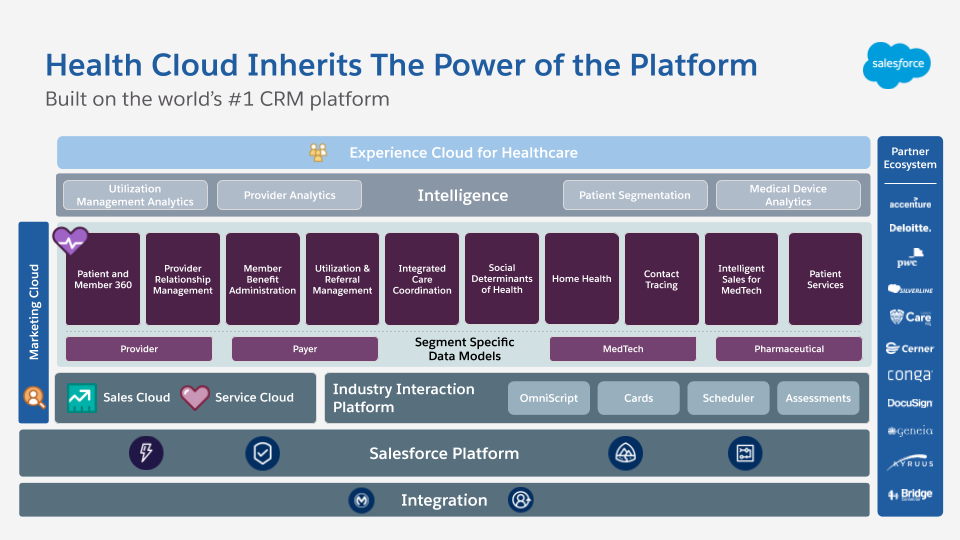
Key values of the Health Cloud Data Model:
- Data model and features are completely oriented around the patient/member
- Designed using HL7 FHIR standards and can operate in a standards-based ecosystem
- Designed to enable multiple connections for patients/members and providers designated by roles and relationships
More specific features are:
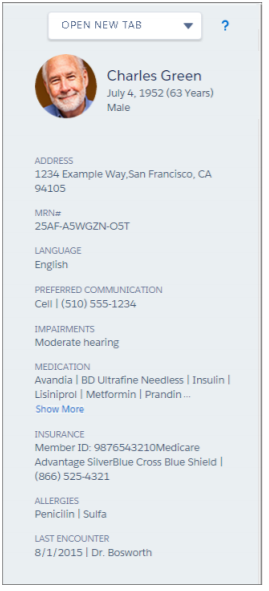
- Patient Card: To effectively manage your patients, you need their information easily available. It consolidates the most important information from a patient’s medical records, such as conditions, medications, and contact information, and displays it all in one place. No more need for searches and multiple clicks to see Patient relevant information.
- Remote Monitoring Exception Management: Streamline the patient and member device registration process and organize and visualize the data to monitor health events over time. Configure when to receive notifications for exceptions, like spikes in weight or blood glucose levels, and apply necessary interventions to improve outcomes and build trust through more personalized, evidence-based interactions.
- Health Timeline: Plan treatments and perform follow-ups more efficiently. The health timeline provides a bird’s-eye view of things like encounters, prescriptions, and tasks that the patient has done or still must complete
Conclusion
At the beginning of the post I have stated three main reasons which we are hearing on why customers build instead of utilizing a pre-built solution and that I will answer what Salesforce’s vision on Life Sciences is and why customizing a non-industry specific org will cost more eventually.
The fact that the Health Cloud:
- Is built on top of the existing platform
- Comes with the needed data models
- Has pre-built interfaces like FHIR R4
- Provides industry related business automations like:
- Patient Enrollment
- Value Based Outcomes Measuring
- Personalized Medicine
- Inventory Management for MedTech Sales etc.
Allows customers to gain value faster instead of having to build and maintain it on their own. Since these functionalities are provided by Salesforce, it also guarantees support and maintenance and reduces technical debt. Here is an illustration that visualizes these benefits:

Another visualization on when to choose Health- vs. Service Cloud
If you have feedback or additional questions for me, I am looking forward to hearing from you.
Kind Regards from Berlin,
Demen
More Resources
Choosing between Service- and Health Cloud
